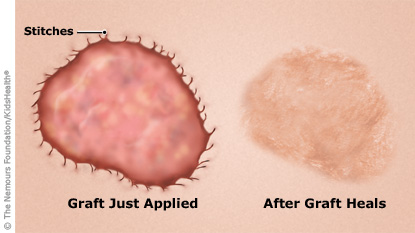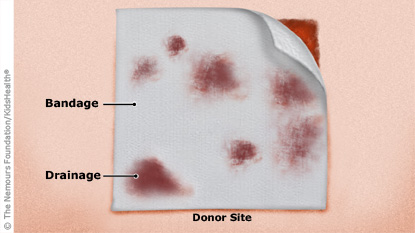A skin graft is a surgical procedure in which a piece of skin is moved from a healthy area (the donor site) and attached to an area that needs to be covered (the skin graft site).
For at least the first month, special care is needed to make sure the skin graft attaches and starts to heal. Full healing takes several months or more. Here's how to care for your child.

Follow your health care provider's instructions for:
- Keeping the surgical sites (graft site and donor site) still.
- Any activities to avoid.
- Giving pain medicines. These may include prescription pain medicine, acetaminophen (Tylenol® or a store brand), or ibuprofen (Advil®, Motrin®, or a store brand). Some prescription pain medicines also include acetaminophen or ibuprofen. To avoid giving too much, give the medicines exactly as your health care provider recommends.
- Giving any other medicines or using any ointments.
- Whether your child needs to wear any compression garments (a special type of clothing that provides support to the area).
- Whether your child needs to raise the skin graft site to prevent swelling. This depends on where the skin graft site is.
- When it's OK for your child to bathe and any special care to take when bathing.
- When and how to change the bandages.
- How to clean the skin graft and donor site.
- Whether your child needs to go for physical or occupational therapy.
- Any other special instructions (such as caring for a splint or a cast).
- When to follow up.
Reminders:
- Feed your child a well-balanced diet to help with healing. Offer them plenty to drink to make sure they stay hydrated (have enough water in the body).
- Cigarette smoke can slow healing. Make your home and car smoke free. For help quitting, call 800-QUIT-NOW (800-784-8669) or visit smokefree.gov.
- Keep your child from scratching at either surgical site. If itching is a problem, talk to the health care provider about ways to treat it.
- Do not put lotions, creams, or ointments on either site without talking to your health care provider.
- Don't give your child any herbal supplements or vitamins without talking to your health care provider.

Why are skin grafts done? Skin grafts are done to help encourage healing and grow new skin in areas that have been damaged by burns, wounds, or an injury.




